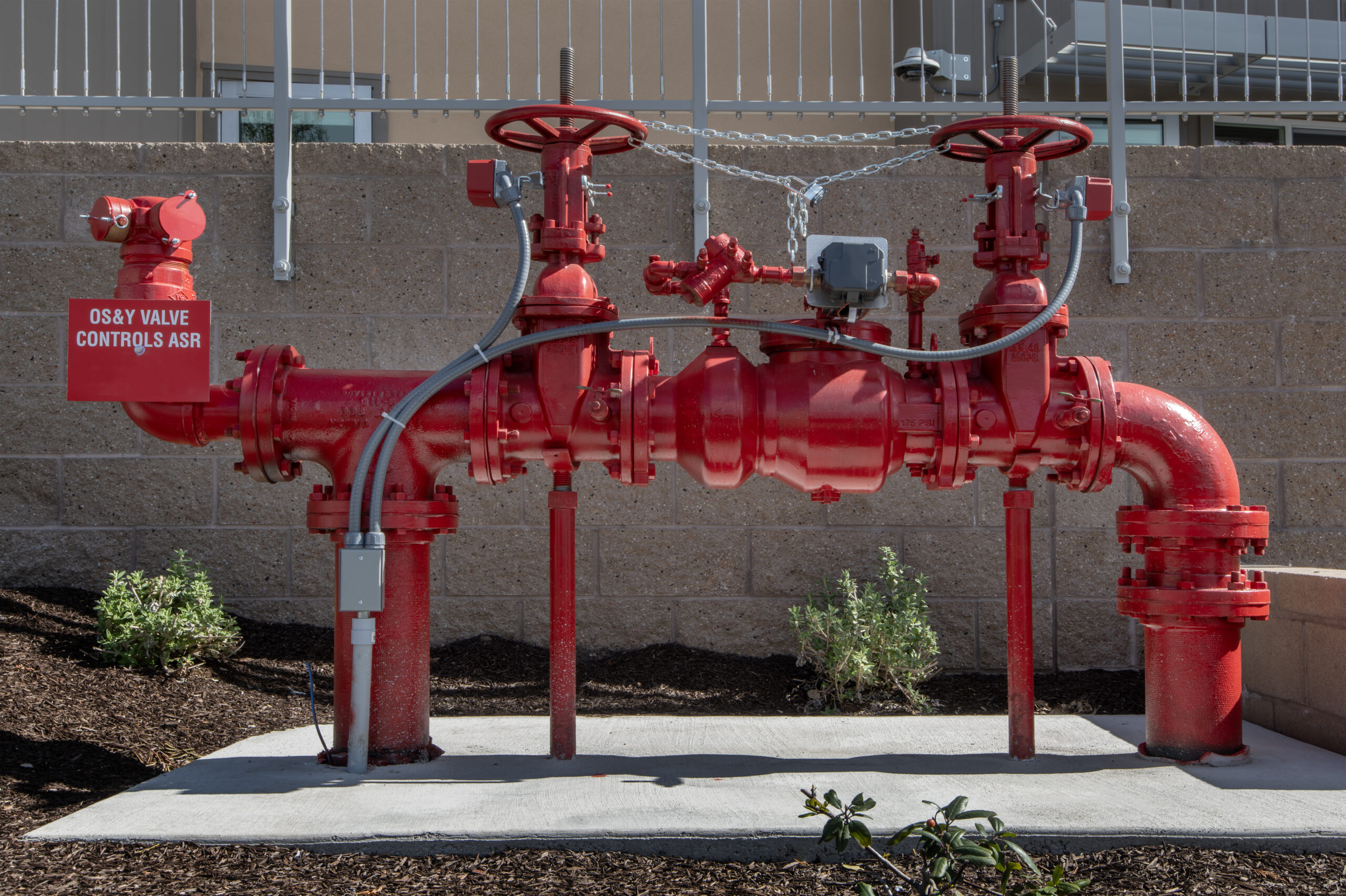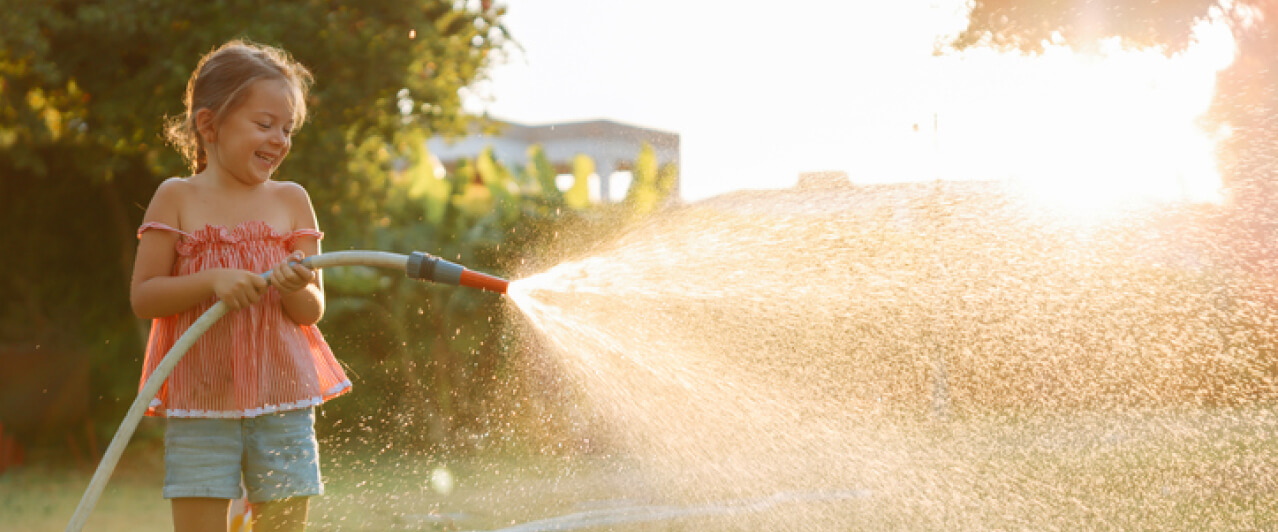Proteja su agua potable: En qué consisten las conexiones cruzadas
En California Water Service, trabajamos arduamente para confirmar que el agua que le suministramos cumpla o supere todos los estándares reglamentarios para el agua potable. Nuestro Programa de control de conexiones cruzadas es una de las tantas herramientas fundamentales que utilizamos para mantener la seguridad del agua potable en todo el sistema de agua, hasta la plomería de su propiedad. Este programa es una asociación entre Cal Water y nuestros clientes. Su comprensión de las conexiones cruzadas y lo que puede hacer para protegerse contra ellas evita la contaminación del suministro de agua potable, de modo que siga siendo seguro para usted y para la comunidad.
¿Qué es una conexión cruzada?
Las conexiones cruzadas son puntos en el sistema de agua donde las fuentes de agua potable, que no son seguras para beber, en su propiedad podrían entrar en contacto con el agua potable. Algunos ejemplos de fuentes de agua no potable son el agua de lavado de un balde, las piscinas, los sistemas de riego de jardines, los rociadores de pesticidas y fertilizantes, las bombas reforzadoras y otros aparatos y equipos que usan agua. Normalmente, el agua potable fluye en una sola dirección hacia su propiedad. Sin embargo, las conexiones cruzadas sin protección podrían permitir el reflujo o flujo inverso de agua contaminada procedente de fuentes no potables de su propiedad hacia el sistema de distribución de agua potable, lo que afectaría la calidad del agua y supondría un riesgo tanto para el sistema de agua potable como para la salud pública. Una tubería principal de agua pública es una tubería que suministra agua potable a su vecindario. Los laterales del servicio de agua de propiedad privada aguas abajo de su medidor de agua son tuberías que conectan la tubería principal con su propiedad.
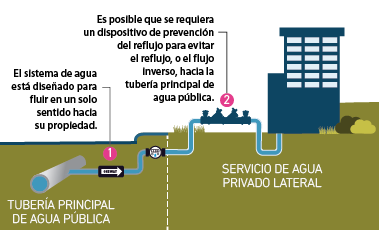
¿Dónde se encuentran normalmente las interconexiones?
Las interconexiones se encuentran en todos los sistemas de plomería residenciales y comerciales. Estos son algunos ejemplos de dónde puede buscar conexiones cruzadas entre el sistema de agua potable y fuentes no potables en su propiedad:
- Grifos para manguera
- Válvulas de descarga para inodoros
- Líneas de llenado de piscinas
- Calderas para la calefacción de espacios
- Bombas de recirculación o reforzadoras
- Sistemas de riego de jardines
- Sistemas de rociadores contra incendios
- Fuente secundaria de agua, como un pozo privado o un estanque
También puede crear conexiones cruzadas temporales cuando sumerge mangueras, por ejemplo, un balde lleno de agua de lavado, o cuando conecta un rociador químico a una manguera.
¿Por qué debería preocuparme por las conexiones cruzadas?
Las conexiones cruzadas pueden introducir contaminantes nocivos en el suministro de agua potable, lo que conlleva riesgos para la salud pública. Algunos ejemplos de contaminantes y peligros que podrían ingresar a su sistema de agua potable sin un control adecuado de las conexiones cruzadas son los siguientes:
Contaminantes biológicos:
- Patógenos nocivos
- Sustancias biológicas, como sangre y materia fecal
Contaminantes químicos:
- Productos de limpieza para el hogar como lejía y detergentes
- Pesticidas y herbicidas utilizados para el control de plagas y malezas
- Abonos
- Anticongelante e inhibidores de corrosión utilizados en sistemas de calefacción y refrigeración
- Metales pesados como el cromo o el plomo utilizados en procesos industriales
Si llegan al sistema de agua potable, estos contaminantes degradan la calidad del agua y pueden causar enfermedades graves.
¿Cómo pueden causar contaminación las conexiones cruzadas?
Para mantener un suministro de agua potable de alta calidad, el agua suministrada a su propiedad debe fluir en una sola dirección. Sin embargo, las conexiones cruzadas sin protección podrían permitir el reflujo (o flujo inverso) de agua contaminada procedente de fuentes no potables de su propiedad hacia su sistema de agua potable. El reflujo degrada la calidad del agua de su propiedad y representa un riesgo para el sistema de agua potable y la salud pública. Pueden producirse reflujos en conexiones cruzadas sin protección debido a las diferencias de presión.
El reflujo puede ocurrir de dos maneras:
- Contrapresión: cuando la presión de una fuente de agua potable (como una caldera) es mayor que la presión del sistema de agua potable, los contaminantes de la fuente de agua no potable pueden introducirse en el agua potable. Los edificios de cuatro o más plantas con bombas reforzadoras pueden generar contrapresión.
- Sifonaje inverso: cuando se produce una caída repentina de la presión del sistema de agua potable, como durante la extinción de un incendio o una rotura de la tubería principal, se puede producir un efecto de vacío o sifonaje que atrae agua no potable y cualquier contaminante presente hacia el agua potable.
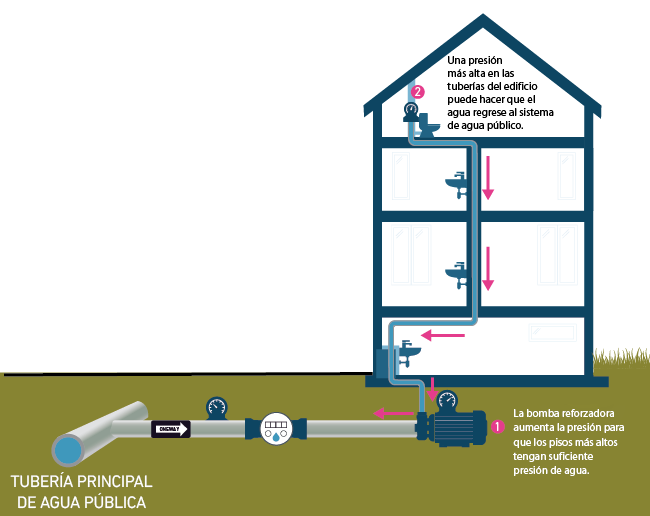
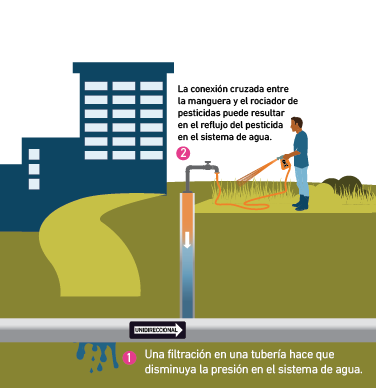
Ejemplos de condiciones de reflujo en conexiones cruzadas debido a diferencias de presión.
¿Cómo evito la contaminación en las conexiones cruzadas?
Un espacio de aire, que es una separación vertical aprobada entre un grifo o tubería de agua potable y el nivel máximo de llenado de un recipiente receptor, puede proteger contra el reflujo en las conexiones cruzadas. También hay varios tipos de dispositivos de prevención del reflujo aprobados para el control de conexiones cruzadas. Estos dispositivos están diseñados específicamente para evitar el flujo inverso hacia el sistema de agua potable cuando se producen cambios de presión.
Existen otros accesorios para instalaciones de plomería que se utilizan en conexiones cruzadas, como los rompedores de vacío para grifos de manguera y las válvulas de control antisifón para riego, que se venden comúnmente en tiendas de mejoras para el hogar. Estos elementos se pueden instalar en su propiedad (por ejemplo, en los grifos para manguera) para proteger la calidad del agua dentro de su propiedad. Sin embargo, solo se pueden instalar dispositivos de prevención del reflujo aprobados y comprobables en su medidor de agua para proteger el lado público del sistema de agua potable.
Para obtener más información sobre el control aprobado de conexiones cruzadas, comuníquese con nuestro gerente del programa local de control de conexiones cruzadas.
¿Cuáles son los requisitos de control de conexiones cruzadas para los propietarios?
Los propietarios son responsables de confirmar que los espacios de aire y los dispositivos de prevención del reflujo en el lado del propietario del medidor de agua, cuando sea necesario, estén correctamente instalados y mantenidos en la propiedad.
Los espacios de aire deben inspeccionarse anualmente. Técnicos certificados en dispositivos de prevención del reflujo deben inspeccionar y probar estos dispositivos una vez al año. Esto ayuda a confirmar que los espacios de aire y los conjuntos funcionan correctamente y continúan protegiendo el sistema de agua potable.
El incumplimiento de estos requisitos podría resultar en la interrupción del servicio de agua hasta que se implemente la protección adecuada contra conexiones cruzadas. Le notificaremos si los resultados del estudio de reflujo indican que su propiedad necesita protección contra el reflujo.
¿Qué medidas puedo tomar para prevenir el reflujo?
No:
- Sumerja las mangueras en piscinas, baldes u otros recipientes.
- Conecte los dispensadores de productos químicos, como los rociadores de pesticidas, a las mangueras.
- Conecte la plomería de agua potable a un electrodoméstico sin los conocimientos adecuados sobre los códigos de plomería y los posibles riesgos.
Qué hacer:
- Mantenga las mangueras almacenadas de forma segura y libres de contaminantes.
- Inspeccione la plomería en busca de posibles conexiones cruzadas sin protección.
- Use espacios de aire o dispositivos de prevención del reflujo aprobados para protegerse contra el reflujo, y programe inspecciones/pruebas cuando sea necesario.
- Contáctenos si nota cambios en la calidad del agua o sospecha que su agua potable está contaminada. La información de contacto del gerente de su programa local de control de conexiones cruzadas se encuentra en el siguiente enlace.
Mantener la seguridad del agua potable: una responsabilidad compartida
La Junta Estatal de Control de los Recursos Hídricos ha establecido nuevos requisitos para que las agencias públicas de agua proporcionen al público más información sobre las conexiones cruzadas. Juntos, podemos mantener el flujo de agua potable en un solo sentido hacia su propiedad, de modo que sea segura para usted y para la comunidad.
Contenido cortesía de California Urban Water Agencies

Informes de calidad del agua
Informes anuales de confianza del consumidor que detallan la calidad del agua, las fuentes de suministro y el cumplimiento de los estándares de salud para cada distrito, a fin de brindar transparencia y confianza del cliente en su servicio de agua.
Explorar informes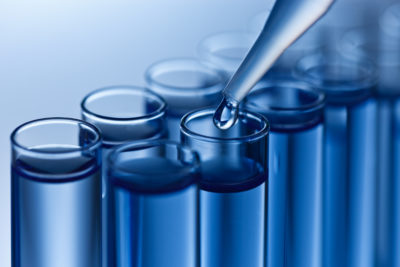
Tratamiento del agua
Cal Water no se basa en un enfoque "universal" para el tratamiento del agua; por el contrario, trabajamos diligentemente para identificar el mejor tratamiento con la mejor relación costo-beneficio que requiere cada fuente hídrica.
Conozca más sobre el tratamiento del agua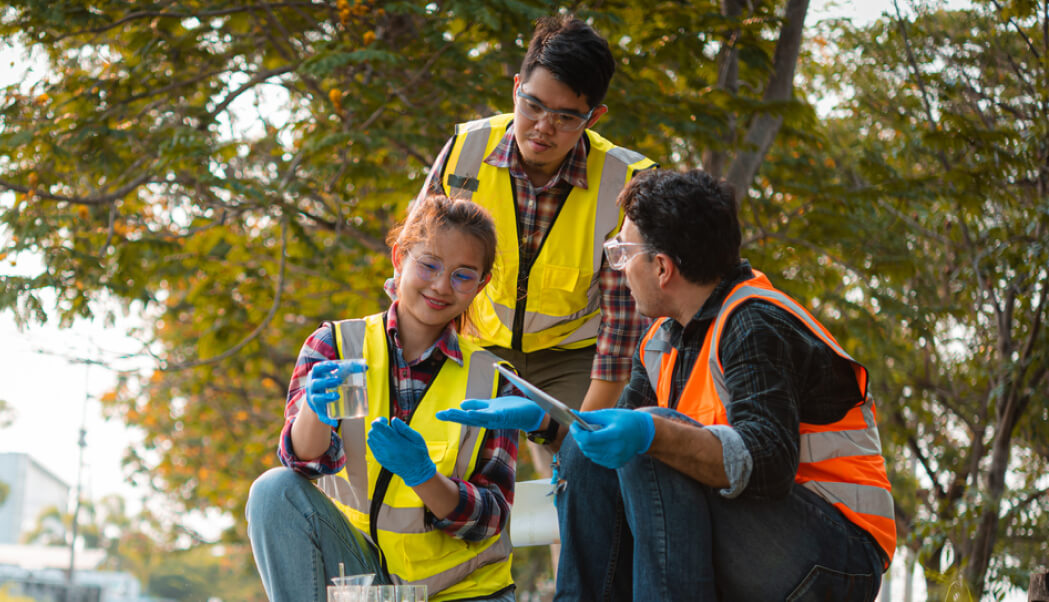
Laboratorios de pruebas de calidad del agua
Cal Water lleva a cabo pruebas exhaustivas de calidad del agua en su laboratorio de última generación en nuestras fuentes y dentro del sistema de distribución. Sin embargo, no realizamos pruebas de calidad del agua en los hogares de los clientes. Si tiene inquietudes sobre el agua de su hogar, comuníquese con un laboratorio acreditado para obtener más información.
Conozca más sobre nuestros laboratorios